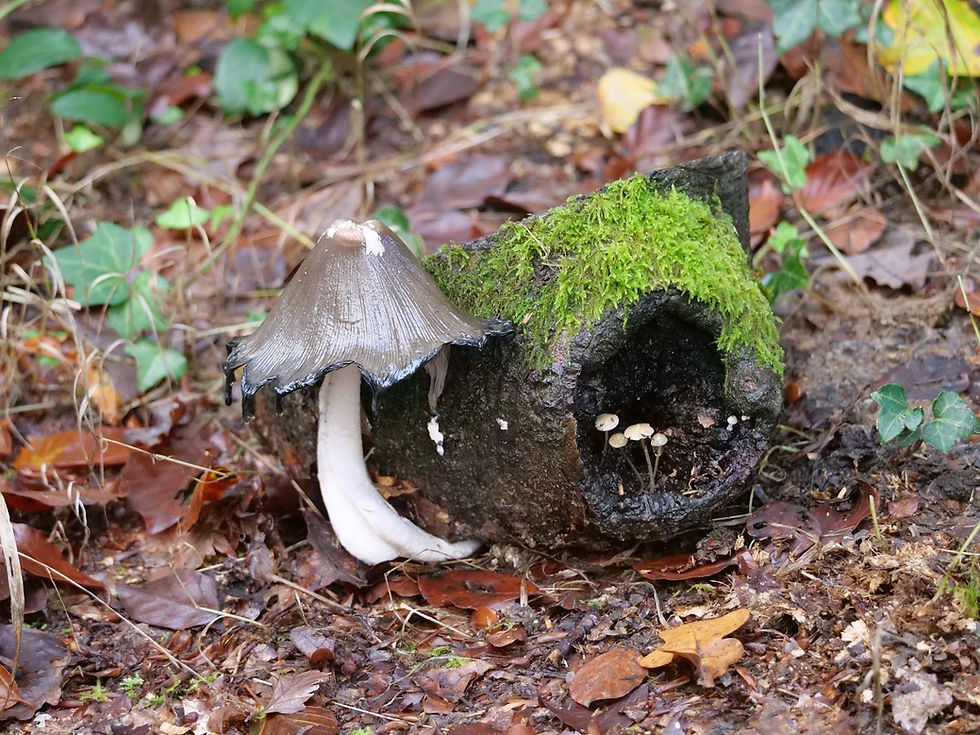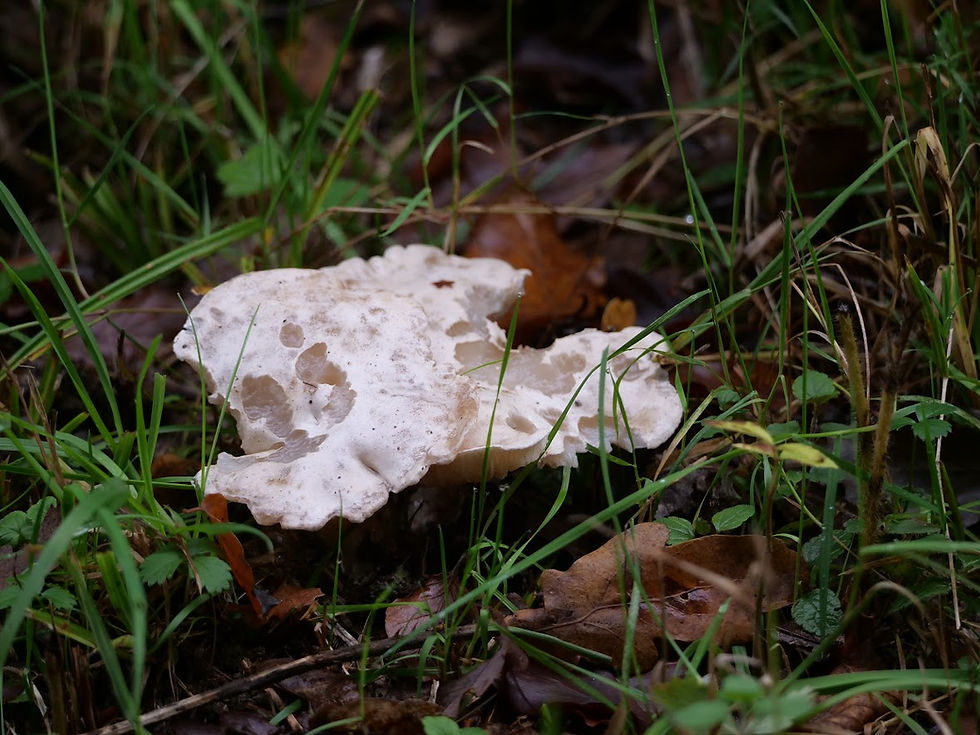Autumn Fungi at Ebernoe Common National Nature Reserve, Sussex Wildlife Trust, West Sussex. 31.10.23
- Sim Elliott

- Nov 2, 2023
- 4 min read
Updated: Nov 16, 2023
I reached Ebernoe from Brighton by train, bus and foot. Details of how to get to Ebernoe is given here: Lichens, Bryophytes, Fungi and Wild Flowers at Ebernoe Common. 07.04.23 It is a three mile walk from the nearest public transport stop (the bus stop in Petworth) and Ebernoe Common, two thirds of which is along a road with no pavement and a third is through country footpaths.
Ebernoe Common is a low weald heath, ancient wood and wood pasture nature reserve managed by the Sussex Wildlife Trust reserve, north of Petworth, see Ebernoe Common | Sussex Wildlife Trust
This post focusses on fungi, but I saw many trees, flowering plants, mosses, liverworts and lichens. Some of the other things I saw can be viewed on my iNaturalist public page: Observations · iNaturalist
All sections of text in italics are quotations, sources sited.
The photographs are presented in the chronological order of my walk.
I am only an amateur naturalist; thus all identifications are provisional; if you note a mistake in identification please feel free to tell me. If you want to contact me about any aspect of this blog, email me at simeon[underscore]elliott[at]gmail[dot]com
Fungi are not always easy to identify. I think I identified 43 different species at Ebernoe; but some of my identification are likely to be wrong, and I may have identified the same fungus more than once with different names. As fungi's fruit, growing fruiting bodies (mushrooms, toadstools, brackets), these fruiting bodies change quickly and decompose/deliquesce quickly after releasing their spores. Decaying/deliquescing fungi are very hard to identify The resources I find useful are Buczacki, Stefan; Shields, Chris; Ovenden, Denys (2013) Collins Fungi Guide : The Most Complete Field Guide to the Mushrooms & Toadstools of Britain & Ireland and Philips (2006) Mushrooms. iNaturalist has useful AI photo identification for fungi (and all species of lfe) and is free to use; and if you submit observations to iNaturalist you will probably get peer feedback if you got the ID wrong. But iNaturalist AI does make mistakes! Picture Mushroom also has useful AI photo identification and is free to use if you don't pay for the enhanced version. And Picture Mushroom AI make mistakes too!
Do not rely on any identification I have made here as an accurate identification with regard to a species and its edibility. I make no comment on the edibility of fungi as I do not forage fungi for food, I just photograph them and leave them where they are for others to enjoy. Remember some fungi are highly poisonous; and some can kill you if eaten.
But you don't need to be able to identify lichen and fungi to enjoy them; I get great pleasure from observing the beauty of things, even when I can't identify what species they are.
Nature England SSSI citation:
Ebernoe Common is of national importance as an example of a large ancient woodland.
Fungi: The site also supports a nationally important assemblage of fungi including seven Red Data Book species: oak polypore Buglossoporus pulvinus, spine-face Creolophus (=Hericium) cirrhatus, coral spine-face Hericium coralloides, pink meadow waxcap Hygrocybe calyptriformis, Collybia racemosa, Coriolopsis gallica and Cortinarius cyanopus. These are species particularly associated with ancient woodland and wood pasture with a significant dead wood resource. Microsoft Word - Ebernoe Common citation for confirmation.doc (naturalengland.org.uk)
I don't think I saw any of these listed fungi, but what I did see was wonderful:
Probably Garlic Parachute, Mycetinis alliaceus

Possibly Sticky Scalycap, Pholiota gummosa


Probably Hairy Curtain Crust, Stereum hirsutum

Probably Common Puffball, Lycoperdon perlatum

Probably Garlice Parachute, Mycetinis alliaceus


Probably Ochre Brittlegill, Russula ochroleuca

Candlesnuff Fungus, Xylaria hypoxylon

Possibly Butter Cap, Rhodocollybia butyracea

Probably Sulphur Tuft. Hypholoma fasciculare

Possibly Orange Birch Bolete, Leccinum versipelle

Possibly The Goblet, Pseudoclitocybe cyathiformis

Possibly False Death-Cap, Amanita citrina

Possibly Butter Cap, Rhodocollybia butyracea

Probably more Sulphur Tuft, Hypholoma fasciculare; extremely common in Sussex Low Weald Woods

Possible Rustgill, Gymnopilus junonius

Probably Sulphur Tuft, Hypholoma fasciculare, on a stump in a pond (possibly created by former clay extraction for the bricks works)

Bulbous Honey Fungus, Armillaria gallica


Possibly Petticoat Mottelgill, Panaeolus papilionaceus

Possibly Liberty Cap, Psilocybe semilanceata

Possibly Sticky Scalycap, Pholiota gummosa


Tree stump is areas of wood pasture with possibly Bulbous Honey Fungus, Armillaria gallica



This Cladonia sp. lichen was probably Branched Pixie-cup Lichen, Cladonia ramulosa growing on the same stump.

Probably Garlic Parachute, Mycetinis alliaceus

ProbablyCoprinellus disseminatus, Fairy Inkcap

Probably Common Rustgill, Gymnopilus penetrans

Possibly Winter Bonnet, Phloeomana hiemalis

Probably Turkey Tail, Trametes versicolor

Probably Sulphur Tuft Hypholoma fasciculare,

Possibly Ferny Bonnet, Mycena pterigena

Probably Stump Puffball, Apioperdon pyriforme

Possibly Saffrondrop Bonnet, Mycena crocata

Wood Hedgehog, Hydnum repandum


A Brachyceran Fly on Wood Hedgehog, Hydnum repandum

Possibly Trooping Funnel, Infundibulicybe geotropa


Probably Pestle Puffball, Lycoperdon excipuliforme

More Garlic Parachutes, Marasmius alliaceus

Probably Sheathed Woodtuft, Kuehneromyces mutabilis

Foreground fungi: possibly Amethyst Deceiver, Laccaria amethystina

Magpie Inkcap, Coprinopsis picacea

Stump Puffball, Apioperdon pyriforme

Magpie Inkcap, Coprinopsis picacea

Magpie Inkcap, Coprinopsis picacea and Winter Bonnet, Phloeomana hiemalis.



Oakmoss lichen, Evernia prunastri, Acorn, Quercus robur, Common Puffball, Mossycoperdon perlatum, and Greenshield Lichen Flavoparmelia caperata

Pestle Puffball, Lycoperdon excipuliforme

More Honey Fungus; very abundant at Ebernoe. Honey fungus is a "white rot"; a pathogen that kills trees, shrubs, woody climbers. Honey fungus grows on living, decaying, and dead plant material.

Magpie Inkcap, Coprinopsis picacea

Possibly Variable Oysterling, Crepidotus variabilis

Possibly Petticoat Mottlegill Panaeolus papilionaceus

Possibly decomposed White Domecap, Leucocybe connata

More Birch Polypores, Fomitopsis betulina

Probably another Parasol, Macrolepiota procera

When things are tricky, I find looking at trees and trying to identify their epiphytes ,really builds my resilience. Salix sp. Upper branches illuminated by bright Hypotrachyna species.; lower branches a collage of greens, mostly from mosses & Cladonia species


Powdered Loop Lichen, Hypotrachyna revoluta

Probably Cypress-leaved Plait-Moss Hypnum cupressiforme

Probably Common Powderhorn, Cladonia coniocraea

Probably more Common Bonnets; Mycena rugosa; a very abundant fungus on branches at Ebernoe


More Honey Fungus, Armillaria mellea

Funeral Bell, Galerina marginata
Some English vernacular names are very useful warnings: eat me and your funeral bell will sound.

Possibly Clouded Funnel Clitocybe nebularis

Mossy stump with some berries from a Holly

More Sulphur Tufts

Possibly Deer Shield, Pluteus cervinus

Felled bent Yew branch

Birch Polypores, Fomitopsis betulina


Hairy Curtain Crust, Stereum hirsutum

Common Bonnet, Mycena galericulata

Ferny Bonnet, Mycena pterigena

More Chicken of the Woods, Laetiporus sulphureus

Sulphur Tuft, Hypholoma fasciculare,

Possibly Saffrondrop Bonnet, Mycena crocata


Probably Variable Webcap, Cortinarius anomalus

More Chicken of the Woods, Laetiporus sulphureus




Possibly Dryad's Saddle, Cerioporus squamosus

Two ancient Birches fallen - with a root to root gap

Sulphur Tuft, Hypholoma fasciculare, in the gap

Possibly Tricholoma viridilutescens

Possibly Blushing Milkcap, actarius controversus





Comments